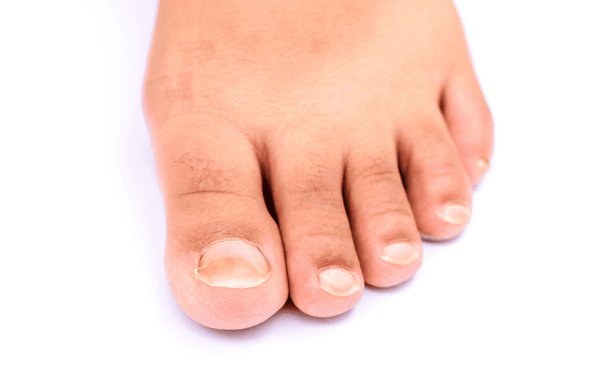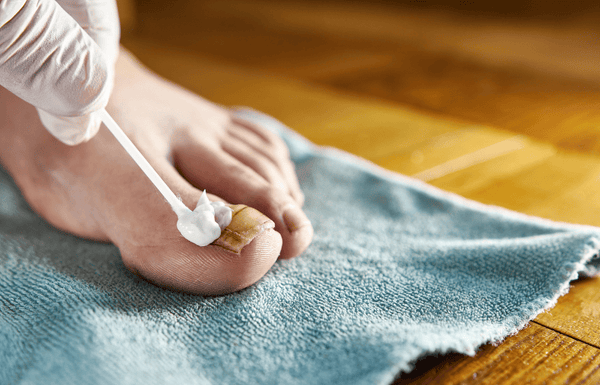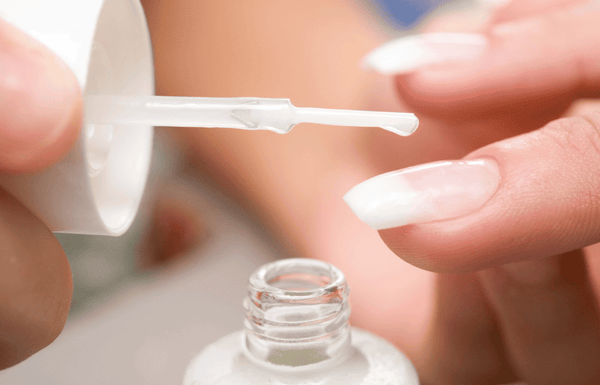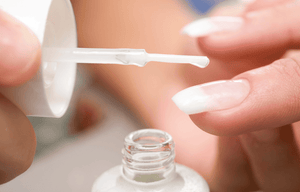
Understanding Nail Fungus (Onychomycosis)
Are you battling nail fungus and overwhelmed by the choices at the drugstore? Likely story.
Figuring out the best way to tackle this incessantly common, stubborn condition can be confusing. Should you use an antifungal cream? An antifungal spray? Both?
Read on to find out how these two common topical treatments work, when to use each, and which might deliver better results for your specific case of nail fungus.
Understanding Nail Fungus (Onychomycosis)
Nail fungus, medically known as onychomycosis, is a fungal infection that affects the nail plate and/or the nail bed. It's a widespread condition that causes cosmetic concerns and, in some cases, can get very uncomfortable physically.
Common Symptoms
Nail fungus can manifest in various symptoms, including:
- Discoloration: Yellow, white, brown, or black, nail beds
- Thickening: Abnormal thickness that makes trimming/clipping difficult
- Brittleness: Infected nail beds can get crumbly, split, or break easily.
- Distortion: The shape of the nail bed may change.
- Separation: The nail may start to lift away from the nail bed.
- Odor: In some cases, an unpleasant smell may be present.
Why It's Hard to Treat
Nail fungus is notoriously difficult to treat for several reasons. Number one, the fungus resides deep within the nail structure, making it challenging for topical medications to reach the infection site.
Nail beds grow slowly, especially toenail beds. It can thus take many months for a healthy nail bed to replace the infected one, even with successful treatment.
The risk of reinfection from nail fungus is also high. Fungi are present everywhere in the environment, making recurring infections common, particularly if no preventive measures are taken.
Finally, some fungal strains may be resistant to certain antifungal medications, which can make the treatment process take longer from medication trial and error.
Antifungal Creams vs Sprays: Differences, Pros & Cons
Anti-Fungal Creams
Antifungal creams are topical medications applied directly to the affected nail and the surrounding. They deliver the active antifungal ingredient directly to the site of infection to attempt to penetrate the nail plate and reach the nail bed, where the fungus resides.
Common Ingredients:
Several antifungal medications are available in cream form, both over-the-counter and prescription. Common active ingredients include:
● Clotrimazole
● Terbinafine
● Tolnaftate
● Ciclopirox (prescription)
● Efinaconazole (prescription)
● Tavaborole (prescription)
Pros:
● Easy to target specific areas
● Often more moisturizing
● Can be massaged into cuticles and nail folds
● Available without prescription in many cases
Cons:
● Poor nail penetration without nail prep
● May be messy or leave residue
● Requires consistent, long-term application
II. Anti-Fungal Sprays
Antifungal sprays are another type of topical medication that delivers the antifungal agent directly to the affected area via a fine mist or aerosol that coats the surface of the nailbed and the skin around the toes.
Common Uses:
While often marketed for athlete's foot, antifungal sprays are also used preventively for healthy nail beds and as a supplementary treatment for nail fungus.
Pros:
● Convenient and fast application
● Can reach between toes and under the nail edge
● Helps reduce moisture and fungal spread in shoes
Cons:
● Less precise than creams
● May not stick to the nail surface well
● Often better for prevention than full-blown treatment
Which Works Better for Nail Fungus?
Creams are generally better for the targeted treatment of nail fungus, especially when used in conjunction with nail preparation techniques like nail filing, soaking in warm water, and using thinning agents to soften the nail and improve the penetration of the medication.
On the other hand, anti-fungal sprays for nail fungus are excellent for preventing fungal infections, particularly in high-risk environments like gyms, swimming pools, and communal showers. Sprays are also helpful for treating very mild or early-stage nail fungus infections.
Sometimes a multi-pronged approach works best. For example, sprays can be used as a supplementary treatment alongside creams or oral medications to help prevent the spread of infection to the surrounding skin and shoes.
Neither Alone May Be Enough for Severe Onychomycosis:
For more severe or persistent cases, neither antifungal creams nor sprays alone may be enough to eradicate the nail fungus. In these situations, oral antifungal medications or prescription-strength topical treatments are often required.
Combination Approach: Cream + Spray
A combination of antifungal cream and spray is often beneficial in some situations. You can apply the cream directly to the infected nail beds, preferably after proper nail preparation, to target the fungus at its source.
Use the spray to treat the inside of shoes and the skin between the toes to help prevent reinfection and address any potential fungal growth in these areas.
By treating both the nails and the surrounding environment, the risk of reinfection is reduced. This combination treatment also addresses both the nail infection and any fungal growth on the adjacent skin, such as athlete's foot.
Antifungal creams and sprays used together can improve compliance and results when used consistently. The convenience of the spray makes it significantly easier to maintain a consistent treatment regimen, which is crucial to completely eradicate the fungus.
When to See a Specialist
While many cases of nail fungus can be managed with OTC treatments, seek professional medical advice in certain situations:
● No improvement after 8–12 weeks of topical use:If you've been using an antifungal cream or spray consistently for several weeks without seeing any improvement, it's time to consult a doctor.
● You have underlying health conditions: Individuals with underlying health conditions like diabetes, circulatory problems, or a weakened immune system are at higher risk of complications from nail fungus and should seek professional care.
● You're unsure whether it's fungus or another nail disorder: Other conditions, such as psoriasis can mimic the symptoms of nail fungus. A doctor can provide an accurate diagnosis and rule out other potential causes.
Final Verdict
Both antifungal creams and antifungal sprays retain their well-deserved place in the fight against nail fungus.
Creams are generally best for the direct treatment of the infected nails, and antifungal sprays offer convenience and are particularly useful for prevention and treating the surrounding environment.
However, remember that neither may be sufficient for more severe fungal infections, and a combination approach or prescription medication may be necessary.
Want to get rid of nail fungus fast? Try Dr. AntiFungus doctor-formulated soaks and sprays today!





